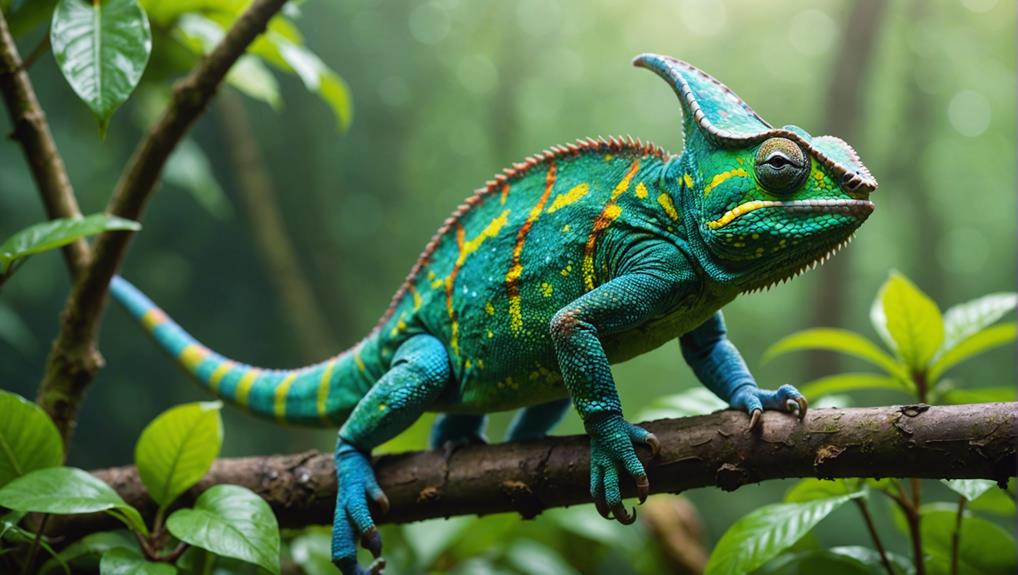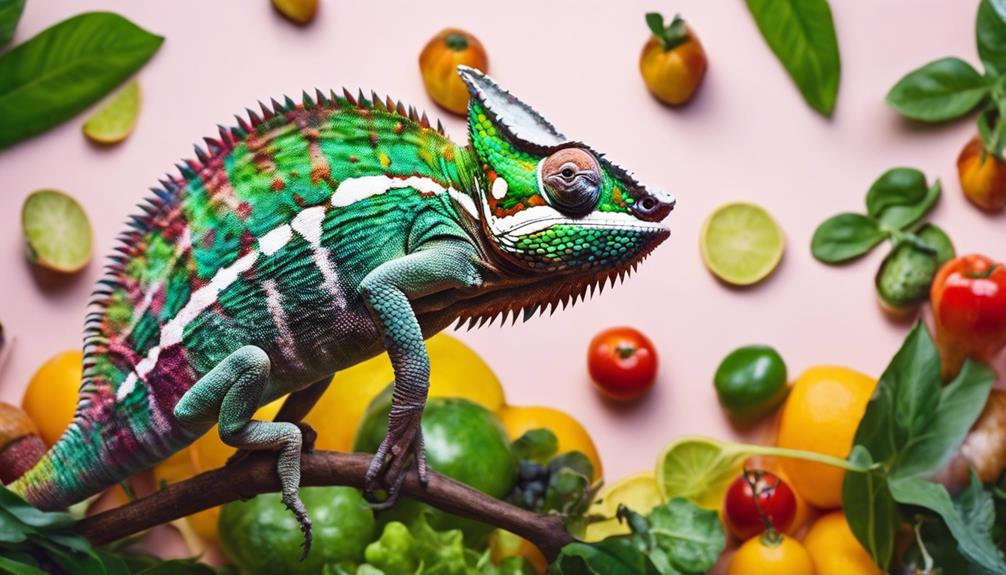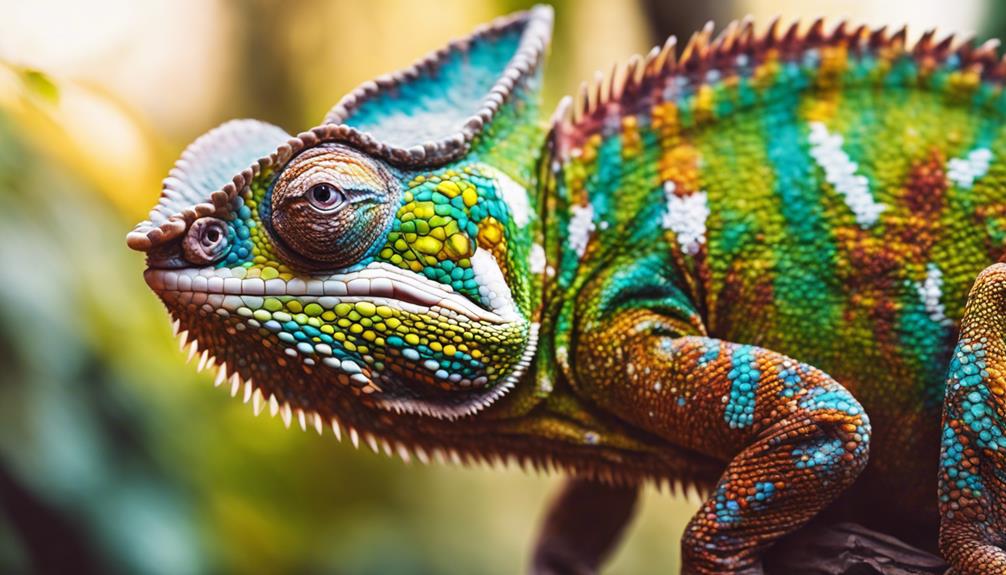Create a Thriving Environment for Your Jackson Chameleon
To provide the best care for your Jackson chameleon, you'll need a well-ventilated enclosure that's at least 24 x 24 x 48 inches in size. This space should be filled with safe live plants and branches for climbing, allowing your chameleon to feel comfortable and stimulated.
Maintaining the right temperature is crucial. Daytime temperatures should range from 70-80°F, with a basking spot reaching up to 85°F. At night, the temperature should drop to around 60-65°F. Humidity levels should be kept between 50-80% using misting and drip systems.
UVB lighting is also essential, and it should be provided for 10-12 hours daily. Your chameleon's diet should consist of gut-loaded insects dusted with calcium and vitamins. Regular health checks are vital, as they help you identify signs of stress or illness early on.
By focusing on these key factors, you'll be able to create a nurturing environment where your Jackson chameleon can thrive.
Habitat Requirements
Creating the perfect habitat for a Jackson chameleon involves maintaining the right temperature, humidity, and lighting conditions.
To start, you'll need to select the appropriate cage materials. A well-ventilated enclosure is vital for your chameleon's health. Opt for a cage with mesh sides rather than solid glass walls. This allows for proper air circulation, which helps prevent respiratory issues. The size of the cage should be at least 24 x 24 x 48 inches to give your chameleon ample space to move and climb.
Live plants are essential for creating a natural and stimulating environment. They provide hiding spots, climbing opportunities, and help maintain humidity levels. Consider using plants like pothos, ficus, and hibiscus. These plants aren't only safe for your chameleon but also thrive in the same conditions. Additionally, they enhance the aesthetic appeal of the habitat, making it more enjoyable for both you and your pet.
When setting up the interior, include branches and vines of various thicknesses. This variety mimics their natural habitat and supports their instinct to climb and explore. Position these elements at different heights to encourage activity and exercise. Make sure the branches are securely anchored to prevent any accidents.
Your ultimate goal is to create a stress-free environment that mimics the Jackson chameleon's natural surroundings. By carefully choosing cage materials and incorporating the right plants, you'll provide a comfortable and enriching habitat. This approach will guarantee your chameleon thrives and lives a healthy, happy life.
Temperature and Humidity
Maintaining the correct temperature and humidity levels is essential for your Jackson chameleon's health and well-being. Proper thermal regulation guarantees they thrive in their environment, mimicking the conditions of their natural habitat.
Aim for a daytime temperature range of 70-80°F and a nighttime drop to around 60-65°F. This variation allows your chameleon to experience a natural day-night cycle, promoting better health and activity levels.
For thermal regulation, provide a basking spot that reaches up to 85°F. Use a reliable thermometer to monitor these temperatures accurately. By doing so, you'll create a comfortable gradient within the enclosure, giving your Jackson chameleon the freedom to move between cooler and warmer areas as needed.
Humidity control is equally important. Jackson chameleons require humidity levels between 50-80%. Keep this in check by misting the enclosure regularly, using a drip system, or installing a fogger. An accurate hygrometer will help you maintain these levels.
High humidity supports their respiratory health and skin shedding process.
- Imagine your chameleon basking under the warmth, feeling secure and at home.
- Picture the lush, misty environment that keeps them hydrated and healthy.
- Think of the freedom they've to explore different temperature zones within their enclosure.
Lighting Needs
In addition to regulating temperature and humidity, proper lighting is essential for your Jackson chameleon's overall health. You'll need to guarantee your pet gets the right amount of UVB light, which helps them synthesize vitamin D3 and properly absorb calcium. Without this, your chameleon can suffer from metabolic bone disease and other health issues.
To provide the necessary UVB exposure, use high-quality UVB bulbs specifically designed for reptiles. These bulbs should be replaced every six months, even if they're still emitting light, as their UVB output diminishes over time. Position the UVB bulb about 6-12 inches from the basking spot, making sure that the light can reach your chameleon without any obstructions like glass or plastic, which can block the UVB rays.
In addition to UVB lighting, you'll need to establish proper light cycles to mimic natural day and night patterns. Aim for about 10-12 hours of light during the day and 12-14 hours of darkness at night. Using an automatic timer can help maintain these light cycles consistently, giving you one less thing to worry about.
Including a basking light is also important. This provides a warm spot where your Jackson chameleon can regulate its body temperature. Make sure the basking spot is around 85-90°F, with the rest of the enclosure being cooler to create a gradient.
Diet and Nutrition
To keep your Jackson chameleon healthy, you need to focus on providing suitable food options, ensuring proper hydration, and incorporating nutritional supplements.
Their diet primarily consists of live insects like crickets and mealworms, which should be gut-loaded before feeding.
Additionally, misting their enclosure and offering a dripper system will help meet their water needs.
Suitable Food Options
Your Jackson chameleon thrives on a varied diet of live insects to meet its nutritional needs. Crickets, mealworms, and roaches are excellent choices, providing the protein and nutrients essential for your pet's health. It's vital to feed your chameleon a range of insects to prevent deficiencies and promote a balanced diet. You should also dust the insects with calcium and vitamin supplements to prevent deficiencies.
Three primary food options that will excite your Jackson chameleon:
Crickets: A staple in your chameleon's diet, they're readily available and easy to gut-load with nutritious food.
Mealworms: These are perfect for occasional treats, offering a crunchy texture that chameleons love.
Roaches: Nutritiously dense and less likely to carry parasites, making them a safe and healthy choice.
In addition to insects, you can occasionally offer safe plants like collard greens or hibiscus leaves, but these shouldn't replace the primary diet of live insects. Feed your Jackson chameleon every other day, adjusting the feeding frequency based on its age and health.
Young chameleons require more frequent feeding than adults, typically once daily. A varied and balanced diet is key to your chameleon's well-being, and providing a mix of insects will help maintain optimal health.
Hydration and Water Needs
Just as important as a varied diet, maintaining your Jackson chameleon's proper hydration is essential for its overall health.
Jackson chameleons display unique drinking behavior; they typically don't drink from standing water. Instead, they prefer to lap up droplets from leaves and other surfaces.
To mimic this natural behavior, you'll need to mist their enclosure regularly. Aim to mist the enclosure at least twice a day, but some keepers find that increasing the misting frequency to three or four times daily works better, depending on the humidity level in your area.
Each misting session should last long enough to thoroughly wet the leaves and surfaces in the habitat, usually around 2-5 minutes. This encourages the chameleon to drink and helps maintain the necessary humidity levels.
In addition to misting, consider using a drip system. A slow-drip system can simulate rain, providing a consistent water source and promoting natural drinking behavior.
Make certain the water is clean and chlorine-free. You can also offer water through a syringe or dropper directly to your chameleon if you notice it isn't drinking enough from misting and dripping.
Consistent hydration will keep your Jackson chameleon healthy and thriving.
Nutritional Supplements
Ensuring your Jackson chameleon gets the right nutritional supplements is essential for preventing deficiencies and promoting overall health. It's not just about feeding them insects; you need to think about supplement types and dosage guidelines to keep them thriving.
Calcium, vitamin D3, and multivitamins are essential for their diet. These supplements help support bone health, metabolic functions, and overall well-being.
When choosing supplement types, opt for high-quality, reputable brands. Each supplement serves a specific purpose:
- Calcium: Prevents metabolic bone disease and supports strong bones.
- Vitamin D3: Aids in calcium absorption; necessary if your chameleon doesn't get enough natural sunlight.
- Multivitamins: Provide essential nutrients that may be missing from their regular diet.
Dosage guidelines are equally important. For calcium, dust their insects lightly at every feeding. Vitamin D3 should be given sparingly, about once a week, to avoid toxicity. Multivitamins can be offered once every two weeks. Always follow the product instructions and consult with a vet for personalized advice.
Hydration Techniques
Providing proper hydration is essential for maintaining the health and well-being of your Jackson Chameleon. These unique reptiles require specific hydration techniques to thrive, and understanding these methods will make a significant difference in their care.
Misting frequency is crucial. Misting your chameleon's enclosure is vital because it replicates the natural humidity they'd experience in the wild. You should mist the enclosure at least twice daily, making certain that the leaves and surfaces are well-soaked. This not only provides drinking water but also helps maintain the necessary humidity levels. You can use a hand mister or an automatic misting system, whichever fits better into your routine and lifestyle. Consistency is key.
Drip systems are excellent for providing a continuous water source for your Jackson Chameleon. Set up a drip system to release water droplets slowly onto leaves or branches within the enclosure. Your chameleon will drink from these droplets, mimicking how they'd hydrate themselves in nature. Verify the drip system is cleaned regularly to avoid any bacterial buildup, and adjust the drip rate to match your chameleon's drinking habits.
Handling Tips
When handling your Jackson Chameleon, it's vital to approach them gently and patiently to avoid causing stress. These creatures thrive in a low-stress environment, and your interaction should reflect that. Always remember that your chameleon is delicate and can easily become anxious if handled too roughly or too often.
To start, use gentle restraint by supporting their body with one hand while allowing them to grip your fingers with their feet. This approach not only provides them with stability but also helps in stress reduction by mimicking the natural support they receive from branches. Avoid sudden movements or loud noises, as these can startle your chameleon and elevate their stress levels.
To facilitate a smooth handling experience:
Support their body: Always provide support to their body to make them feel secure.
Move slowly: Sudden actions can scare them; slow and steady movements keep them calm.
Limit handling time: Prolonged handling can lead to unnecessary stress, so keep interactions brief and meaningful.
Letting your chameleon come to you on their own terms is vital. Place your hand in their enclosure and let them climb onto you when they're ready. This method respects their need for autonomy and reduces stress substantially. If your chameleon shows signs of stress, such as changing color rapidly or trying to escape, it's best to return them to their enclosure and try again later.
Health Monitoring
Maintaining your Jackson Chameleon's health involves regular monitoring to catch any signs of illness early. One essential aspect of this is weight tracking. Weigh your chameleon weekly using a small digital scale. Consistent weight loss can indicate underlying health issues. Keep a log of the weights to notice any trends. If you observe a sudden drop or continuous decline, it's a sign that you should consult a veterinarian.
Pay attention to stress indicators as well. Jackson Chameleons can show stress in various ways, including darkening of their skin, excessive hiding, or lack of appetite. Stress can weaken their immune system, making them more susceptible to illnesses. Verify their habitat is set up correctly with ample foliage, proper lighting, and humidity levels to minimize stress.
Also, observe their eating and drinking habits closely. A healthy Jackson Chameleon should have a good appetite and be interested in food. They should also drink regularly; you can often see them licking water droplets from leaves. Dehydration can be a serious issue, so make certain they're hydrated by misting their enclosure several times a day.
Regularly check their skin and eyes. Healthy skin should be smooth and free of sores or swelling. Eyes should be bright and alert, not sunken or swollen. If you notice any abnormalities, it's vital to act quickly.
Lastly, monitor their behavior and activity levels. Jackson Chameleons should be active and curious. Lethargy or disinterest in their surroundings can be an early sign of health problems. By keeping a close eye on these factors, you can guarantee your chameleon stays healthy and happy.
Common Health Issues
Jackson Chameleons, like all pets, are susceptible to a range of common health issues that owners should be aware of.
One of the most frequent problems is parasite infections. These can be internal, like worms, or external, like mites. You may notice weight loss, abnormal stools, or lethargy. Regular vet check-ups and maintaining a clean environment can help prevent and treat these infections.
Respiratory issues are another concern. These can arise from inadequate humidity levels or poor ventilation in your chameleon's enclosure. Symptoms include wheezing, excessive mucus, or open-mouth breathing. Ensuring proper humidity and a well-ventilated habitat can greatly reduce the risk of respiratory problems.
Another common issue is metabolic bone disease (MBD), which results from a lack of calcium or vitamin D3. Signs include soft or deformed bones, difficulty climbing, and tremors. Providing a balanced diet and proper UVB lighting can help prevent MBD.
To keep your Jackson Chameleon healthy and thriving, watch for these signs:
- Weight loss or lethargy: Could indicate parasite infections.
- Open-mouth breathing or wheezing: Possible respiratory issues.
- Difficulty climbing or tremors: Signs of metabolic bone disease.
Breeding Information
Breeding Jackson Chameleons requires careful planning and a thorough understanding of their specific needs.
To begin, you'll need to create the right environment. Jackson chameleons thrive in a space that mimics their natural habitat, with ample foliage for hiding and climbing. Verify the enclosure is adequately sized and well-ventilated to keep them healthy and stress-free.
Mating behavior in Jackson chameleons is fascinating to observe. Males typically initiate the process by displaying vibrant colors and engaging in a series of head bobs and body sways to attract a female's attention. If the female is receptive, she'll remain calm and allow the male to approach. If not, she may exhibit aggressive behavior to ward him off.
It's vital to monitor their interactions closely to prevent any harm.
Once mating is successful, the female enters a gestation period, which usually lasts between five to six months. During this time, it's essential to provide her with ideal conditions, including proper nutrition and a stress-free environment. Guarantee she's access to high-quality food rich in calcium and other essential nutrients to support the development of the embryos.
When the gestation period concludes, the female will give birth to live young rather than laying eggs, which is unique compared to many other reptile species. Typically, a single birthing event can result in anywhere from 8 to 30 offspring.
After birth, separate the young chameleons from the adults to prevent any accidental harm and to guarantee they receive adequate care and nutrition.
Lifespan and Growth
Understanding the lifespan and growth of Jackson chameleons is essential for providing them with the best possible care. These fascinating reptiles typically live around five to ten years in captivity, depending on several lifespan factors. Key elements such as diet, habitat, and overall health play significant roles in determining how long your chameleon will thrive.
Jackson chameleons undergo various growth stages, starting as tiny hatchlings and gradually maturing into majestic adults. In their first year, they experience rapid growth, doubling or even tripling in size. During this stage, it's essential to provide a nutrient-rich diet and proper UVB lighting to support healthy development. As they grow older, their growth rate slows, and they enter a more stable phase of life.
To evoke some emotion and connect with your passion for these unique creatures, consider the following:
- Witnessing their transformation: Watching your Jackson chameleon grow from a tiny hatchling into a full-grown adult is a rewarding experience.
- Bonding moments: Each stage of their life offers new opportunities to bond and learn about their unique behaviors.
- Providing freedom: Ensuring they've a spacious and well-equipped habitat can make a world of difference in their overall well-being.
Conclusion
Taking care of a Jackson chameleon involves understanding its specific needs.
Provide a suitable habitat with correct temperature, humidity, and lighting.
Feed a balanced diet and maintain proper hydration.
Regularly monitor your chameleon's health and be aware of common issues.
If you're interested in breeding, understand the requirements.
With proper care, your Jackson chameleon can live a healthy and fulfilling life.
Stay informed and attentive to give your pet the best care possible.


